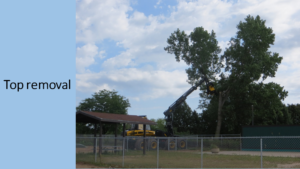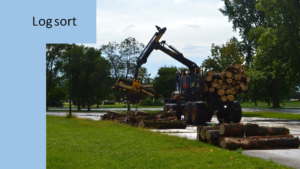By Don Peterson, Wisconsin Urban Wood
 With thousands of trees on their properties, municipalities and other urban ownerships sometimes need to remove a large volume of trees at once, such as after an insect or disease outbreak (i.e., emerald ash borer) or a catastrophic weather event (wind/tornadoes or ice/snow damage). When this need arises, what are the options available to remove these trees efficiently, safely, cost effectively and quickly?
With thousands of trees on their properties, municipalities and other urban ownerships sometimes need to remove a large volume of trees at once, such as after an insect or disease outbreak (i.e., emerald ash borer) or a catastrophic weather event (wind/tornadoes or ice/snow damage). When this need arises, what are the options available to remove these trees efficiently, safely, cost effectively and quickly?
Mechanized logging equipment has become the standard for traditional tree harvests in most of the country’s rural forests. Using this type of equipment in urban tree removal projects is in its infancy, but it can be a very effective tool in the right circumstances.
Advantages of tree removal by mechanized logging equipment include:
- Length of removal operations
-
- Time of felling and processing ranges from 1-10 minutes per tree depending on tree size.
- Depending on several variables, typically 100-200 trees can be felled, processed and removed in one day.
- Operator safety
- Trees are felled and processed by the harvester operator in an enclosed cab using an extended cutting head on a mechanical arm.
- The processed wood products are picked up at the stump by the forwarder whose operator is also in an enclosed cab and puts all the products on the forwarder bunk with a grapple loader.
- Marketing of wood products
-
- A larger volume of any one product (saw logs, pulpwood, firewood, chips) typically makes marketing the product more economical.
 When these large-scale removal needs arise, municipalities and other entities typically lack experience with mechanized logging or wood product markets. Conversely, loggers have no or limited experience in urban settings, causing consternation for both parties on how to move forward with implementing such a project. An initial contact with your Wisconsin DNR Urban Forestry Coordinator can direct you to the technical assistance needed to initiate such a project.
When these large-scale removal needs arise, municipalities and other entities typically lack experience with mechanized logging or wood product markets. Conversely, loggers have no or limited experience in urban settings, causing consternation for both parties on how to move forward with implementing such a project. An initial contact with your Wisconsin DNR Urban Forestry Coordinator can direct you to the technical assistance needed to initiate such a project.
Unlike a typical timber harvest, the purpose of this type of project is to reduce the cost of tree removal, not to generate income. There are several factors that anyone bidding on an urban tree removal project must consider that will affect their bid and how the municipality or other entity would handle the project. These factors include:
- If there are several trees in the removal project that can’t be removed by the logging equipment, it might make sense for a tree service company to bid on the project and subcontract with a logger or vice versa.
- Because urban tree removal projects are often far removed from where a logger normally operates, the logger might only be interested in doing the actual removal operations and have no interest in marketing the wood products. In this case, the municipality would be responsible for marketing the products, typically through a broker or some type of contracted agent. The same could be true of a contract with a tree service company where the municipality would also be responsible for marketing the products.
- If there are seasonal restrictions on when the trees can be removed (limiting removal to one or two months of the year), consider what would be a reasonable length of time for the contract (1-3 years). Ask yourself if you’re willing to pay more for a quicker turnaround; would you accept a bid that is substantially higher if the project could be completed in only one year?
 This is a quick overview of the concept of large-scale removals of urban trees. This type of removal is being successfully implemented in locales such as the Kenosha County Park system and the City of Racine. One member of Wisconsin Urban Wood who has specialized in these removals is Koerner Forest Products from Oshkosh.
This is a quick overview of the concept of large-scale removals of urban trees. This type of removal is being successfully implemented in locales such as the Kenosha County Park system and the City of Racine. One member of Wisconsin Urban Wood who has specialized in these removals is Koerner Forest Products from Oshkosh.
For more information or details about this type of removal, please contact Wisconsin Urban Wood at 608-622-7212 or director@wisconsinurbanwood.org.
